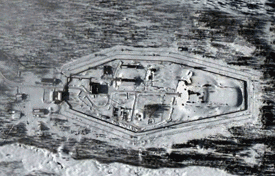 (Pictured: The proverbial nuclear wasteland)
(Pictured: The proverbial nuclear wasteland)
In recent years, when applied to the United States, the term “exceptionalism” has escalated from its usual first meaning — uncommon — to its second — extraordinary. Meanwhile, when it comes to the planet on which we live, Americans and the rest of its inhabitants may not exactly be earth exceptionalists, but we are earth-centric. Since the earth is our only frame of reference, we’re alternately resigned to how its history repeats itself or we’re wracking our brains, trying to figure out how to navigate the next millennium as if nothing like it had ever been done before — by anyone, anywhere in the universe.
As one disposed, by nature, to believe in alien life forms, I often ask myself about the various obstacles with which we’re confronted or those of our own making: How do they do they surmount them on other planets? For example, does anyone really believe that a civilization elsewhere that may be a millennium — or a million of them — older than ours bases its economy on capitalism and free markets? It doesn’t take much imagination to see that dwindling resources require a managed economy, at the least, to parcel out what’s left.
Recently, however, the pendulum of my perspective has begun to swing back to earth-centric. Recent thinking places planets that just might host human life forms at the far reaches of the universe. In other words, prospects for a community of planets inhabited with humanoids, in our corner of the universe anyway, may be slim and none. In fact, it may be a millennium before such planets are even visible via telescopes. Last spring, at Astrobiology Magazine, Dan Choi wrote:
Although our telescopes will likely become good enough to detect signs of life on exoplanets [planets revolving around another sun besides ours. — RW] within the next 100 years, it would probably take many centuries before we could ever get a good look at the aliens.
Signs of life may be all we see because what’s required is not the most powerful telescope of all time, but a series of telescopes.
To begin imaging even giant organisms 30 feet long and wide on the closest putative exoplanet [which is] 4.37 light years away, the elements making up a telescope array would have to cover a distance roughly 400,000 miles wide. . . . The area required to collect even one photon [the basic unit of light — RW] a year in light reflected off such a planet is some 60 miles wide.
In other words, it’s likely that we’re more alone than I had thought. The logical response then is to value the planet for its uniqueness as if it were a priceless museum piece which we pledge to keep out of harm’s way.
It’s difficult to believe that many still view the earth as a raw resource to be developed, when, in fact, such a pursuit comes perilously close to rifling the pockets of a corpse. Unless, that is, they’re convinced that once the earth is used up, they can colonize another planets. (Mining aside, some scientists maintain that Mars and other planets may be arable.)
More likely, environmental concerns are tuned out because of an inability to stomach the messengers — whether progressives in general or scientists who hold no truck with creationism. But it’s folly to believe that when the earth finally keels over and expires, colonization and migration can be ramped up on demand.
In the end, when it comes to planets conducive to the care and feeding of advanced life forms, earth is likely a space oasis. Which should serve to firm up one’s commitment to nuclear disarmament. For when it comes to ravaging the earth, a nuclear attack accelerates the entropy of global warming many times over. The number of dead may result in a suddenly sustainable population, but that’s a poor consolation prize for the physical and psychic trauma inflicted on the survivors. Complete with a radioactive landscape and nuclear winter as well, nuclear war can send the planet on a fast track to hell.
